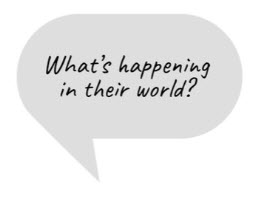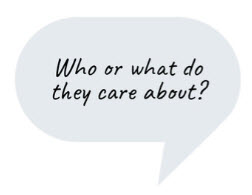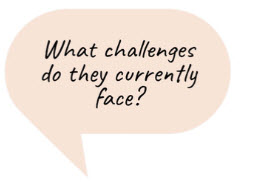Doesn’t it seem that Murphy’s Law (anything that can go wrong, will go wrong) always happens when the pressure’s on, a deadline needs to be hit, or that super important presentation (that you’ve been working on for weeks) is almost complete? If there’s one thing for certain (especially in today’s business culture)… change is inevitable.
So, what’s the key to staying on track and avoiding disaster? Use this constant disruption to create empathy with your audience. If you’re feeling the heat of change, your audience is probably feeling it too (and maybe ten times worse). The best storytellers step outside of their world and walk in their audience’s shoes. The more your story addresses your audience’s unique perspective, the more relevant it will feel to them.
When doing this digging on your audience, ask yourself these three questions:

What’s Happening in Their World?
Discovering this helps establish your story setting and gets everyone in the room to nod with agreement. What you’re telling them makes sense, describes the space they operate in, and provides critical focus for what comes next in your story.
Example: “When purchasing or renewing insurance, consumers have many resources at their fingertips.”
Who or What do They Care About?
 This becomes the main character in your story that helps to establish an emotional connection with the audience. It’s human for us to want to relate to characters, and it helps you humanize what often can be abstract (customers, suppliers, key stakeholders, etc.). You could give your character a name (Meet Beth, a young mother…), or use yourself (I was shopping yesterday…), or unnamed groups, like in the case of our insurance story example above, the characters are consumers.
This becomes the main character in your story that helps to establish an emotional connection with the audience. It’s human for us to want to relate to characters, and it helps you humanize what often can be abstract (customers, suppliers, key stakeholders, etc.). You could give your character a name (Meet Beth, a young mother…), or use yourself (I was shopping yesterday…), or unnamed groups, like in the case of our insurance story example above, the characters are consumers.

What Challenge(s) are They Facing?
Remember that disruption and change we were empathizing about… well every great story, especially for your audience, has conflict. Conflict is what keeps your audience up at night, and is the critical thing they may be focused upon that gives them a reason to lean in and care about what you’re telling them. Conflict in our insurance story could be a business competitor, or industry consolidation, or digital disruption that has changed how consumers purchase insurance products. Revealing conflict in your story lets you be the hero twice… first when you identify a problem, and then again when you propose a way to fix it.
Remember: It’s Not About You
In an imperfect world, setting the foundation with an audience-centric approach will allow you to zig and zag your storytelling no matter what the situation. Our Golden Rule? It’s not about you. It’s always about your audience.
Want more tips for crafting stories that powerfully connect with your audience? Our Crafting Strategic Visual Stories workshop will arm you and your teams with practical strategies to “walk in your audience’s shoes” and craft compelling business narratives that drive action. Click here to learn more!
